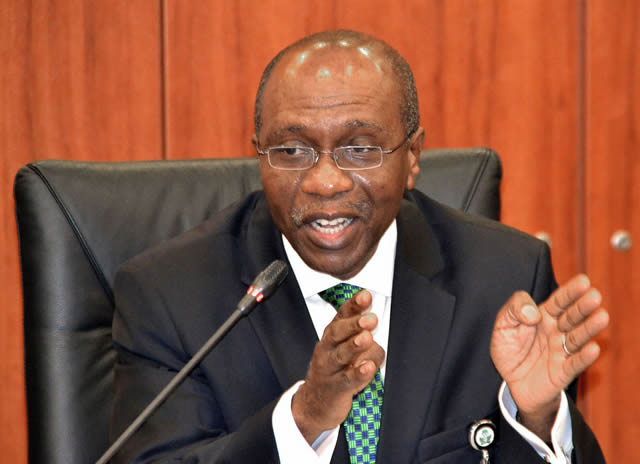
The Central Bank of Nigeria Monetary Committee has recommended that the apex bank’s anchor borrowers should be extended to other agricultural products such as fish and palm oil.
“The Committee called on the CBN to extend the success recorded under the Anchor Borrowers Programme to other items, including fish and palm oil, etc by introducing more stringent measures to curb access to foreign exchange for products that can be produced within Nigeria.”
These recommendations emanated from a communiqué issued by the Committee at the end of its meeting today, Thursday.
The committee believed that although the domestic economy was recovering modestly from recession, but that the recovery was tepid and efforts should be stepped up to strengthen aggregate output and demand. The Committee therefore advised the CBN to deepen and broaden access to finance to high employment elastic sectors with particular emphasis on small and medium scale enterprises.
Part of the communiqué reads thus:
“The Monetary Policy Committee (MPC) met on the21stand 22ndof November, 2018, amidst a resurgence ofglobal inflationary pressures, increased fragilities in the global financial markets, weakening crude oil prices, continuous capital flow reversal and moderate currency depreciations, especially in the emerging markets as well as a strengthening US dollar and subdued global economic growth outlook. The Committee appraised recent developments in the global and domestic macroeconomic and financial environments, as well as the economic outlook for the first half of 2019.In attendance were eleven (11) members of the Committee.
Global Economic Developments
The Committee noted the contraction in global output, underpinned largely by escalating trade tensions resulting in widespread uncertainty and waning investor confidence. Consequently, global growth in 2018 has been downgraded to 3.7 per cent from the earlier projection of 3.9 per cent. Growth softened in major advanced economies in the third quarter of 2018.In the Emerging Markets and Developing Economies (EMDEs),growth remained divergent, reflecting a combination of country-specific factors.
Thus, growth in the advanced economies is expected to remain at 2.4 per cent in 2018, supported by strong output growth in the US projected at 2.9 per cent. The U.S. expansionary fiscal stance, strong wage growth and continued inflow of capital into U.S. dollar denominated assets, are expected to provide the impetus for growth. In the United Kingdom, growth remained weak, hampered by uncertainties around Brexit negotiations. Growth in the Euro Area, projected at 2.0 per cent, appears to be subdued by low domestic aggregate demand amidst relatively high unemployment and reduced global trade .In the Emerging Markets and Developing Economies, growth was revised downwards to 4.7 per cent from the earlier projection of 4.9 per cent, largely in anticipation of a slowdown in China as the country is confronted with an adverse external trade environment.
Overall, the downside risks to global economic activity remained: elevated financial fragilities and policy uncertainties, the gradual erosion of rule-based multilateral trading system, tighter financial conditions with latent disruptive portfolio adjustments, increased capital flow reversals with potentials for heightened exchange rate depreciation and some volatility, fiscal fragilities and increased debt burden, geo-political tensions and increasingly depressed aggregate demand in some countries. These factors will continue to shape developments for the rest of 2018 and into 2019.
The MPC also noted that monetary policy in most advanced economies, particularly the US, continued on a path of normalisation in view of strong wage growth and declining unemployment. The Bank of England hiked its policy rate in August 2018, while the European Central Bank (ECB)has given guidance to terminate its asset purchase programme in December 2018. The Committee was concerned that these developments will in the medium term, accentuate capital flow reversals from emerging and developing economies, including Nigeria.
Domestic Output Developments
The Committee noted the positive outlook for output growth, evidenced by the Manufacturing and Non-manufacturing Purchasing Managers Indexes (PMI), which stood at 56.8 and 57.0 index points, respectively, in October 2018, indicating expansion for the 19th and 18th consecutive months. This was attributed to the stability in the foreign exchange market, implementation of the 2018 capital budget and the on-going intervention of the Central Bank of Nigeria (CBN) in the real sector of the economy. However, the recent incidence of flooding across the country and the impact of herdsmen attack on farming communities could affect output growth for the rest of the year.
Overall, the Committee believes that, even though output recovery remains fragile, the effective implementation of the 2018 capital budget, relative improvements in power supply, progress with counter-insurgency in the North-East and sustained intervention by the CBN in the real sector, will improve the investment climate and reduce unemployment. Consequently, the MPC reaffirmed its support for all initiatives designed to stimulate domestic output growth.
Developments in Money and Prices
The Committee noted that broad money (M2) grew by 6.52 per cent in October 2018 over its level at the end-December 2017; and annualised to a growth rate of7.82 per cent, which was below the provisional benchmark of 10.48 per cent for 2018.The growth in M2 was largely due to the significant growth in Net Foreign Assets (NFA) which grew by 20.71 per cent in October 2018, annualised to 24.85 per cent which is above the 2018 provisional growth benchmark of 14.50 per cent. Credit to Government and Net Domestic Credit (NDC) expanded by 7.43 and 2.71 per cent, annualized to 8.92 and 3.26 per cent, respectively; but below the annual benchmark of 13.10 and 17.40 per cent, respectively. Credit to the private sector grossly underperformed as it grew by 1.94 per cent, annualised to 2.33 per cent, below the 2018 benchmark of 12.40 per cent. The underperformance of the monetary aggregates was of concern to the MPC, which urged the CBN to ensure improved credit delivery to the small and medium scale industries, particularly to the unbanked urban and rural populations.
The Committee noted the benign performance of inflation, as headline inflation (year-on-year) decreased to 11.26 percent in October 2018 from 11.28 per cent in September2018aftertwo consecutive months of marginal increases. The drop in headline inflation was driven by food inflation, which moderated to 13.28 per cent in October from 13.31 per cent in September 2018. Core inflation, however, inched up marginally to 9.9 per cent in October 2018 from 9.8 per cent in the previous month. On a month-on-month basis, headline and food inflation also moderated to 0.74 and 0.82 per cent in October from 0.84 and 1.0 per cent in September 2018, respectively, while core inflation increased from 0.64 per cent in September 2018 to 0.80 per cent in October 2018.
The Committee noted that the moderation in inflation was largely seasonally driven and was therefore, unsustainable as prices were expected to pick towards the end of the year. However, the MPC observed that the near-term upside risks to inflation remained; the disruption to agricultural production and distribution arising from flooding, insurgency in the North-East, herdsmen-farmer crisis, high cost of energy, anticipated spending in the run-up to Christmas festivities and campaign-related spending towards the upcoming 2019 general elections. Accordingly, the Committee enjoined the appropriate authorities to continue to address these challenges and to sustain the implementation of the 2018 budget and the Economic Recovery and Growth Plan of the Federal Government to ameliorate the supply side constraints.
Money market interest rates oscillated throughout the review period, reflecting fluctuations in banking system liquidity. Inter-bank call and Open Buy Back (OBB) rates, which stood at16.00and 17.08 per cent, respectively, on September 26, 2018, declined moderately to 14.00 and 16.31 per cent, respectively, on October 24, 2018. On average, interbank call and OBB rates rose from 8.68 and 7.64 per cent in September 2018 to 14.18 and 13.93 per cent, respectively, in October 2018, closing at 10.00 and 9.72 per cent, respectively, on November 21, 2018. The developments in net liquidity position and flows which culminated in higher market rates reflected the impact of higher risk perception in the market, withdrawals from the banking system for monthly statutory disbursements to states and local governments; OMO sales and foreign exchange interventions.
The average naira exchange rate remained relatively stable and converging at both the Bureau-de-Change (BDC) and the Investors’ and Exporters’ (I&E) window segments of the foreign exchange market during the review period. The exchange rate at the I & E window opened at N364.00/US$ and closed at N363.90/US$ with a daily average of N363.87/US$ between September 26 and November 16, 2018. At the BDC segment, the exchange rate opened at N360.00/US$ and closed at N361.85/US$, with a daily average of N360.98/US$, over the same period. The relative stability in the foreign exchange market, the MPC noted, was attributable to the sustained policies of the Bank to increase the supply of foreign exchange from autonomous sources. Gross official reserves decreased from US$42.60 billion at end-September, 2018 to US$41.53 billion on 16th November, 2018.
The Committee noted the bearish trend in the equities segment of the capital market during the review period. Thus, All-Share Index (ASI) decreased by 8.70 per cent from 34,848.45 on August 31, 2018 to 32,058.28 on November 16, 2018. Similarly, Market Capitalization (MC) decreased by 8.72 per cent from N12.72 trillion to N11.70 trillion during the same period. Relative to the end-December 2017, the indices decreased by19.29 and 16.32 per cent, respectively. These developments largely reflect the sustained profit taking activities by portfolio investors as foreign yields become increasingly more attractive abroad. The MPC, however, believes that this trend will reverse in the medium term given the current efforts at further improving investor confidence and the relative stability in the Investors and Exporters (I&E) window of the foreign exchange market.
The Overall Outlook and Risks
Forecasts of key macroeconomic variables indicate a positive outlook for the economy inQ4 of 2018. The Committee expects that the effective implementation of the Economic Recovery and Growth Plan (ERGP) and the 2018 budget, improvements in the security challenges, enhanced flow of credit to the real sector and stability in the foreign exchange market will redirect the economy on a path of inclusive and sustainable growth. Increased production in the oil and the non-oil sectors are also expected to drive output growth in the medium term. The Committee, however, acknowledged the downside risks to this outlook to include: reduced portfolio inflows, weak of fiscal buffers, low domestic credit, and sluggish aggregate demand.
The inflation outlook suggests continued but moderate inflationary pressure to the end of 2018, based largely on increased consumer spending for the Christmas festivities, election-related expenditure and increased pace of implementation of the 2018 Federal government budget. Improvements in the security, increased harvests as well as a stable exchange rate are expected to moderate the rise in inflation.
Overall, the outlook for the economy remains positive witha growth projection of 1.75 per cent in 2018.
Committee’s Considerations
The Committee assessed the macroeconomic environment in 2018 and noted the modest stability thus far achieved in domestic prices, output growth and the financial system. The Committee noted that the economy was on the right path but some key sectors continued to experience significant challenges. The MPC, however, expressed concern about the tepid growth expectations and growing uncertainty in the global financial markets arising from the poor reception of the Brexit deal by British politicians, continuing trade war between the US and her major trading partners, as well as the commencement of US sanctions on Iran.
The Committee believed that although the domestic economy was recovering modestly from recession, however, the recovery was tepid and efforts should be stepped up to strengthen aggregate output and demand. In this regard, the Committee urged the CBN to deepen and broaden access to finance to high employment elastic sectors with particular emphasis on small and medium scale enterprises. The Committee called on the CBN to extend the success recorded under the Anchor Borrowers Programme to other items including fish and palm oil, etc. by introducing more stringent measures to curb access to foreign exchange for products that can be produced within Nigeria.
The MPC welcomed the moderation in inflation in October, reflecting declining food prices. The Committee believes that given the negative output gap, the proposed increase in the national minimum wage would stimulate output growth due to prolonged weak aggregate demand arising from salary arrears and contractor debt. Consequently, its impact on the aggregate price level would be largely muted, given that the monetary aggregates have largely underperformed in fiscal 2018.In addition, the prevailing stability in the foreign exchange market would continue to moderate pressures on the domestic price level.
The MPC noted the improvements in the financial stability indicators, including non-performing loans, capital adequacy and liquidity ratios of the Deposit Money Banks (DMBs). It urged the Bank to sustain its surveillance over the Banking industry by taking prompt corrective measures to further improve stability in the system. The Committee also called on the fiscal authorities to build significant buffers to strengthen the efficacy of monetary policy.
Overall, the MPC considered the options to loosen, hold or tighten. The Committee continues to hold the view that although loosening would encourage the flow of credit to the real sector, help in reduction of the aggregate cost of credit and spur business spending and investment, thereby reinforcing the CBN’s support for output growth and economic recovery, it, however, believed that doing so will reverse more rapidly, the gains of price and exchange rate stability achieved so far given the liquidity impact that would entail. The ensuing liquidity will exert pressure on the exchange rate in the light of increased capital flow reversals arising from monetary policy normalisation by the US Fed. This would further depress the capital market.
As for tightening, The MPC holds the view that, while tightening will strengthen the stability of the foreign exchange market because of its dampening effect on the demand for foreign exchange, it was however convinced that this would simultaneously dampen investment growth, widen the output gap, depress aggregate demand and weaken output growth.
The MPC recognises the fact that it had held the policy rate and other policy parameters constant over the last several meetings. The Committee underscores that by holding its policy position constant; it has confidence in the various policies and administrative measures deployed by the Bank which have resulted in the moderation in domestic price levels and stability in the foreign exchange rate. Thus, a hold position is an expression of confidence in the policy regime, given the gradual improvements in both output growth and price stability. On this premise, the downside risks to growth and upside risks to inflation appears contained.
The Committee’s Decision
In light of the above, the MPC decided by a vote of all eleven (11) members present to HOLD.
In summary, the MPC voted to:
1. Retain the MPR at 14 per cent;
2. Retain the asymmetric corridor of +200/-500 basis points around the MPR;
3. Retain the CRR at 22.5 per cent; and
4. Retain the Liquidity Ratio at 30 per cent.








